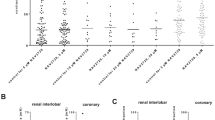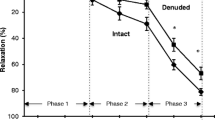Abstract
Pranidipine, a new calcium channel modulator, prolonged endothelium-dependent relaxation induced by acetylcholine in a aortic ring preparation, contracted with prostaglandin F2α. This action was not shared by amlodipine. The effect was not modified by indomethacin, suggesting that the action of pranidipine does not involve prostanoid metabolism. NG-nitro-L-arginine completely prevented the action of Pranidipine. The drug affected neither nitric oxide (NO) synthase activity nor the level of cyclic GMP in the vessel. Pranidipine did not affect the sensitivity of the contractile proteins to calcium. Pranidipine also did not alter cyclic GMP-induced relaxation in a-toxinskinned vascular preparations. Pranidipine also prolonged glyceryl trinitrate-induced relaxation in the endothelium denuded rat aorta. Furthermore, pranidipine enhanced relaxation of the aorta induced by glyceryl trinitrate even in the presence of methylene blue, a guanylyl cyclase inhibitor. This action was not modified by iberiotoxin or by charybdotoxin, two inhibitors of the calciumactivated potassium channel. The results strongly suggest that pranidipine enhances cyclic GMPindependent NO-induced relaxation of smooth muscle by a mechanism other than through NOinduced hyperpolarization. These effects were in direct contrast to amlodipine, another new 1,4dihydropyridine calcium antagonist.
Similar content being viewed by others
References
Taira N: Differences in cardiovascular profile among calcium antagonists. Am J Cardiol 59: 24B–29B, 1987
Godfraind T, Miller R, Wibo M: Calcium antagonism and calcium entry blockede. Pharmacol Rev 38: 321–416, 1986
Nakayama N, Ikezono K, Mori T, Yamashita S, Nakayama S, Tanaka Y, Hosokawa T, Minami Y, Masutani K, Yamamura Y, Yabuuchi Y: Antihypertensive activity of OPC-13340, a new potent and long-acting dihydropyridine calcium antagonist, in rats. J Cardiovasc Pharmacol 15: 836–844, 1990
Nakayama N, Ikezono K, Fujio N, Sasabe H, Kitaura K, Tamada S, Shirafuji T, Yabuuchi Y: OPC-13340, a new potent long-acting dihydropyridine calcium antagonist. Cardiovasc Drug Rev 9: 147–157, 1991
Nakayama N, Ikezono K, Ohura M, Yabuuchi Y: Effects of the new long-acting dihydropyridine calcium antagonist pranidipine on the endothelium-dependent relaxation in isolated rat aorta in vitro. Arzneim-Forsch/Drug Res 43: 1266–1270, 1993
Mori T, Nakayama N, Ohura M, Ikezono K, Kinoshita S, Kamata M, Hosokawa T, Yamashita S, Yabuuchi Y: Cardiovascular effects of OPC-13340, a potent, long-acting 1,4-dihydropyridine calcium channel blocker, in dogs. Arch Int Pharmacodyn Ther 321: 41–56, 1993
Miyakoda G, Nakayama N, Matsui K, Yabuuchi Y: Mechanisms of the potent long-lasting antihypertensive action of the new calcium channel blocker pranidipine. Evidence for strong affinity to the calcium channels or membrane. Arzneim-Forsch Drug Res 45: 471–475, 1995
Horiuti K: Mechanism of contracture on cooling of caffeinetreated frog skeltal muscle fibers. J Physiol 398: 131–148, 1988
Takeuchi T, Kishi M, Ishii T, Nishio H and Hata F: Nitric oxidemediated relaxation without concomitant changes in cyclic GMP content of rat proximal colon. Br J Pharmacol 117,1204–1208, 1996
Harafuji H, Ogawa Y: Re-examination of the apparent binding constant of ethylene-glycol-bis-(b-aminoethyl-ether)-N,N, N′,N′-tetraacetic acid with calcium around neutral pH. J Biochem 87: 1305–1312, 1980
Nilius B, Viana F, Droogmans G: Ion channels in vascular endothelium. Ann Rev Physiol 59:145170, 1997
Mayer B, Brunner F, Schmidt K: Inhibition of nitric oxide synthesis by methylene blue. Biochem Pharmacol 45: 367–374, 1993
Bolotina VM, Najibi S, Palacino JJ, Pagano PJ, Cohen RA: Nitric oxide directly activates calcium-dependent potassium channels in vascular smooth muscle. Nature 368: 850–853, 1994
Ohura M, Mori T, Watanabe K, Ikezono K, Nakayama N, Tominaga M, Yabunchi Y: Effects of pranidipine (OPC-13340), a novel 1,4-di-hydropyridine derivative Ca-antagonist, on isolated porcine coronary contraction and acute myocardial ischemia in the pig. Folia Pharmacol Jpn 103: 101–109, 1994
Nishinaka Y, Yokota M, Watanabe M, Sobue T, Iwase M, Ukai M, Ando A, Nagata K, Saito H: Hemodynamic effects of the calcium channel blocker pranidipine on exercise-induced angina. Int J Clin Pharmacol Ther 32: 542–549, 1994
Hirano T, Ohura M, Orito K, Fujiki H, Miyakoda G, Mori T: Venodilator effects of pranidipine, a novel 1,4-dihydropyridine calcium antagonist, in rats: Comparison with nifedipine and amlodipine. Eur J Pharmacol 324: 201–204, 1997
Author information
Authors and Affiliations
Rights and permissions
About this article
Cite this article
Mori, T., Takeuchi, T., Ohura, M. et al. Pranidipine, a new 1, 4-dihydropyridine calcium channel blocker, enhances cyclic GMP-independent nitric oxide-induced relaxation of the rat aorta. Mol Cell Biochem 178, 335–343 (1998). https://doi.org/10.1023/A:1006827801386
Issue Date:
DOI: https://doi.org/10.1023/A:1006827801386




